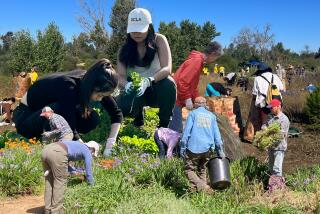Refrain for Fab Fruits: Strawberry Yields Forever
- Share via
Gardeners who grow strawberries will tell you there’s nothing more delicious than a berry pulled out of the garden and popped right into your mouth. Bursting with flavor, vine-ripened strawberries are soft, juicy and unforgettable.
A low-growing perennial with pretty green foliage and small white flowers, the strawberry is the quickest cropping of all garden fruits. And now is the perfect time to plant strawberries, which are available at many nurseries.
There are two main types of strawberries--the well-known traditional berry that tops strawberry shortcake and the more unusual Alpine strawberry. The Alpine is a small berry and a descendant of wild strawberries from the mountains of Italy. A gourmet delicacy in Europe, Alpines have an intense flavor reminiscent of raspberries.
In our mild climate, Alpine strawberries and many traditional berries, such as Seascape, Quinault and the pink-flowered Pink Panda, bear year-round, producing their heaviest crop in spring.
Keep the following planting guidelines in mind:
* Choose a sunny spot that doesn’t get too hot in the summer. Many strawberries will bake in extreme temperatures. On hot days, use shade cloth or plant tall annuals nearby such as sunflowers, corn and beans.
* Lighten the soil. Strawberries like an easy-to-work, well-draining soil. Amend generously with an organic material such as homemade or bagged compost or planter mix.
* Try containers. Pots are often a good choice for growing berries. Not only do they drain quickly, container growing gives you greater control over the soil, resulting in fewer weeds and soil-borne disease and pests.
Use a container with good drainage holes. Fill with pre-moistened potting mix and give each plant two to four inches of space.
* Use care when planting. It’s critical that you plant strawberry plants so that the crown is properly positioned. This is the thick portion in the center of each plant from which the roots extend.
Plant so that the crown is a quarter to a half-inch in the ground and a quarter to a half-inch aboveground. You’re usually safe if you plant established plants at exactly the same level you find them in containers. Once planted, firm soil around roots well.
* Try bare-root plants when possible. Buying bare-root provides you with an inexpensive means of planting many berry plants. These dormant plants have been dug from growing fields and had most of their soil removed. They are a real bargain, costing just pennies apiece.
* Fertilize regularly. Strawberries are heavy feeders. Give plants a strong start by adding nitrogen to the ground before planting. Some good organic, slow-release nitrogen fertilizers to add include blood meal, bat guano or a high nitrogen bone meal.
When the plants flower, fertilize again with bone meal, which will provide necessary phosphorus and potassium. Don’t feed plants much nitrogen at this point or you’ll get excessive leaf growth and no fruit. Fertilize in-ground plants once a month and container plants every two weeks.
A variety of area nurseries have strawberry plants in stock, including Laguna Nursery in Laguna; Laguna Hills Nursery in Lake Forest; Armstrong Garden Center in Santa Ana; M&M; Nursery in Orange; and Kitano’s Garden Center in La Palma. M&M; and Kitano’s have bare-root.






